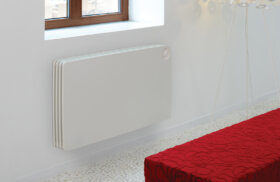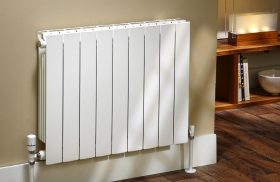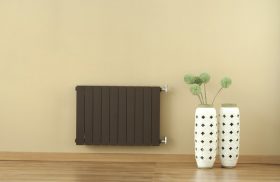Stainless steel is corrosion-resistant and therefore doesn’t need extra protection to keep it in good condition; however, you do need to take proper care with cleaning and maintenance in order to keep it in the best possible condition.
Let’s dive in on how to clean a bathroom radiator or stainless steel towel rail using the correct tools and techniques.
Understanding Stainless Steel Radiators
Stainless steel is a super durable material and stainless steel radiators are more resistant to corrosion and rust – which can be a common issue with radiators. An important point to note if you’re wondering about the type of radiator or towel rail to install in your bathroom.
A stainless steel radiator is the ideal option for a hot and wet environment, however, it still requires proper maintenance and care to remove moisture and bacteria. The good news is that it’s easy to keep clean, making it fairly low maintenance.
With such a wide range of stainless steel radiators on the market, it can be tough to find the right one for you. From the different kinds of finishes – brushed or polished – and designs – the vertical and horizontal models to rounded edges and various sizes – you’re spoilt for choice.
At the Radiator Centre, we have a tasteful selection of designer stainless steel radiators that will not only transform your living space but also do what they were designed to do – heat your home.
Preparing for Cleaning
Regularly cleaning your stainless steel radiators will ensure their longevity and durability. But before you start cleaning, there are certain safety precautions to ensure a safe and effective cleaning process.
- Turn off each radiator – make sure your radiator is turned off and allow it to cool down completely. This will prevent the risk of burns or accidents while cleaning.
- Wear protective gear – it’s advisable to use gloves and eye protection to shield yourself from any cleaning solutions or potential debris that may be dislodged during cleaning.
- Gather suitable cleaning products – choose cleaning products that are specifically designed for stainless steel radiators. Avoid abrasive or harsh cleaners that can damage the stainless steel finish – it’s advisable to first patch test the cleaner on a small area first.
- Ventilate the area – don’t forget to crack open a window or use a fan to circulate the air to emit any fumes.
- Follow proper cleaning techniques – use a soft, non-abrasive microfibre cloth rather than rough brushes that can scratch the surface.
- Avoid excess water – avoid excessive water contact with any electrical components of the radiator.
Cleaning Methods
Now for the fun part – actually cleaning! There are certain cleaning methods you can utilise to ensure your radiator is cleaned thoroughly and safely. Whether you use a homemade cleaning solution, soapy water or a detergent, make sure the ingredients are suitable for your particular radiator.
Surface Cleaning
This method includes using a dry microfibre cloth or soft radiator brush to gently remove dust and debris from the radiator’s surface. This helps prevent scratching the surface during the cleaning process.
Dip the soft cloth or sponge into warm water and wring it to get rid of excess water. Gently wipe down the radiator’s exterior following the direction of the grain. Following this, rinse the cloth with clean water and wipe down again.
Then finally, use a clean, dry cloth to dry the radiator.
Deep Cleaning
A deep clean includes a more rigorous cleaning. If your radiator or stainless steel towel radiator is in a poorer condition or is overdue for a clean then you may want to opt for this method.
In order to get rid of stubborn stains or a grease buildup, you’ll need to start with a dry surface clean then use a homemade solution like white vinegar and lemon juice or a stainless steel cleaner to remove the grime. Dip a cloth in the mixture and carefully rub it onto the radiator.
Follow by cleaning with a fresh, damp cloth and don’t forget to dry it off too!
Fin Cleaning
Your bathroom radiator may have fins on the rear so cleaning these is key to keeping it performing optimally. The fins play an important role in increasing the radiator’s surface area which makes for better heat transfer.
Over time, the fins can get clogged with dust and debris, hindering the heat transfer efficiency and also restricting the airflow. A radiator with fins that are cleaned regularly tends to have a longer lifespan but remember to approach the cleaning process gently and be cautious not to bend or damage the fins.
There are various tools and techniques to clean the fins properly:
- Soft radiator brush
- Compressed air cans
- Vacuum cleaner
- Fin comb
- Microfibre cloth or duster
Polishing and Protecting
To restore the shine and lustre of your stainless steel radiator, you’ll need to first have a good cleaning regimen. In addition to cleaning with warm water and using stainless steel cleaners, you can also invest in a polishing cloth specially designed for stainless steel surfaces.
There are also a variety of stainless steel polishes available but be sure that it won’t be harsh or abrasive on your radiator. If you’d rather opt for a natural alternative, a bit of olive oil on your dry microfibre cloth will give your stainless steel radiator that brand new shine.
Maintenance and Preventive Tips
It’s essential to establish how often your radiator needs to be cleaned. Typically, stainless steel radiators and towel rails in the bathroom should be cleaned at least once a week due to the excessive moisture and bacteria they are exposed to.
In order to prevent dust accumulation, it’s a good idea to regularly dust in between the fins with a radiator brush or use a vacuum cleaner. Maintaining the cleanliness of your radiator is an imperative part of making it last longer and even enhance its efficiency.
If you’d like basic maintenance tips to help keep your designer radiators in tip-top condition, visit the radiators Frequently Asked Questions section of our website.





